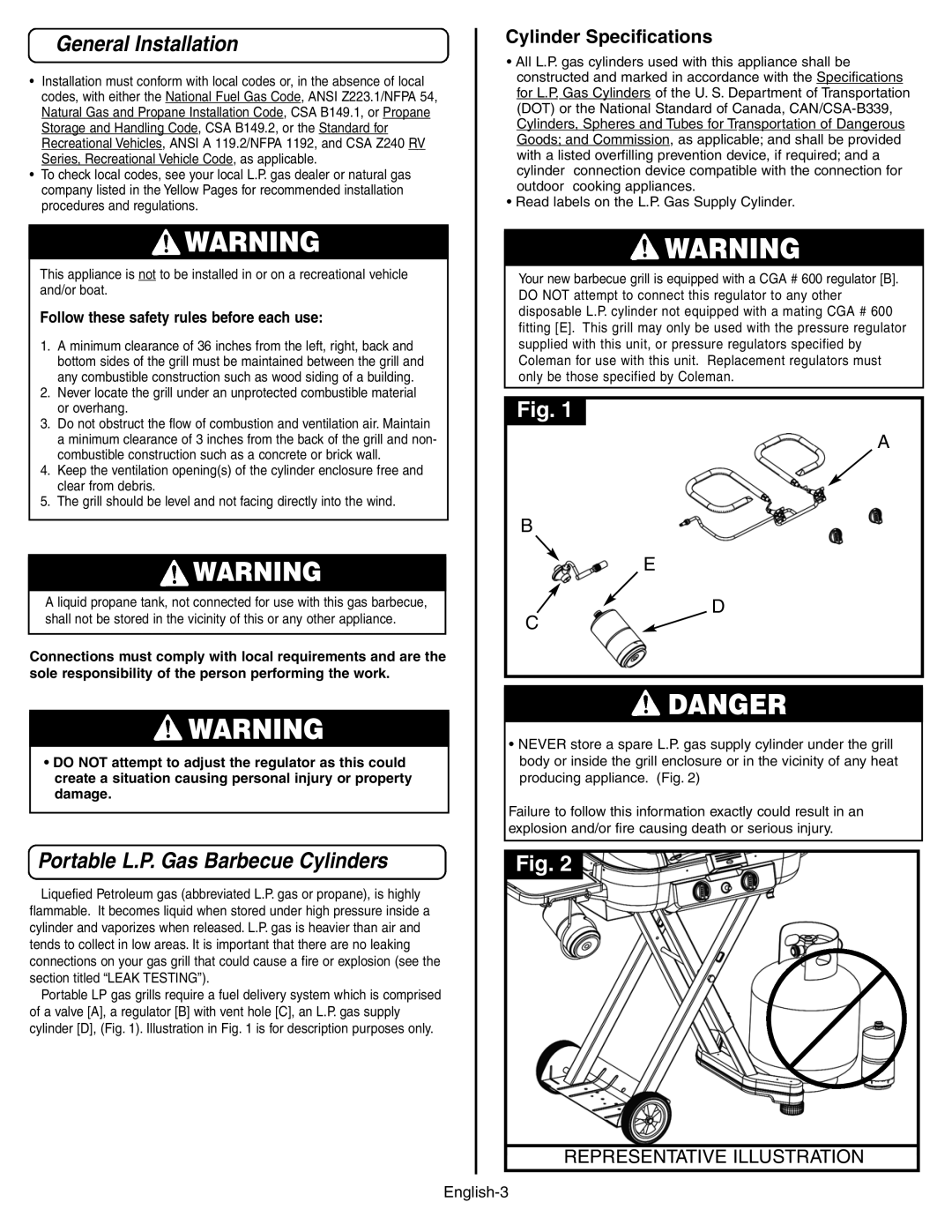
General Installation
•Installation must conform with local codes or, in the absence of local codes, with either the National Fuel Gas Code, ANSI Z223.1/NFPA 54, Natural Gas and Propane Installation Code, CSA B149.1, or Propane Storage and Handling Code, CSA B149.2, or the Standard for Recreational Vehicles, ANSI A 119.2/NFPA 1192, and CSA Z240 RV Series, Recreational Vehicle Code, as applicable.
•To check local codes, see your local L.P. gas dealer or natural gas company listed in the Yellow Pages for recommended installation procedures and regulations.
![]() WARNING
WARNING
This appliance is not to be installed in or on a recreational vehicle and/or boat.
Follow these safety rules before each use:
1.A minimum clearance of 36 inches from the left, right, back and bottom sides of the grill must be maintained between the grill and any combustible construction such as wood siding of a building.
2.Never locate the grill under an unprotected combustible material or overhang.
3.Do not obstruct the flow of combustion and ventilation air. Maintain a minimum clearance of 3 inches from the back of the grill and non- combustible construction such as a concrete or brick wall.
4.Keep the ventilation opening(s) of the cylinder enclosure free and clear from debris.
5.The grill should be level and not facing directly into the wind.
![]() WARNING
WARNING
A liquid propane tank, not connected for use with this gas barbecue, shall not be stored in the vicinity of this or any other appliance.
Connections must comply with local requirements and are the sole responsibility of the person performing the work.
![]() WARNING
WARNING
•DO NOT attempt to adjust the regulator as this could create a situation causing personal injury or property damage.
Portable L.P. Gas Barbecue Cylinders
Liquefied Petroleum gas (abbreviated L.P. gas or propane), is highly flammable. It becomes liquid when stored under high pressure inside a cylinder and vaporizes when released. L.P. gas is heavier than air and tends to collect in low areas. It is important that there are no leaking connections on your gas grill that could cause a fire or explosion (see the section titled “LEAK TESTING”).
Portable LP gas grills require a fuel delivery system which is comprised of a valve [A], a regulator [B] with vent hole [C], an L.P. gas supply cylinder [D], (Fig. 1). Illustration in Fig. 1 is for description purposes only.
Cylinder Specifications
•All L.P. gas cylinders used with this appliance shall be constructed and marked in accordance with the Specifications for L.P. Gas Cylinders of the U. S. Department of Transportation (DOT) or the National Standard of Canada,
•Read labels on the L.P. Gas Supply Cylinder.
![]() WARNING
WARNING
Your new barbecue grill is equipped with a CGA # 600 regulator [B]. DO NOT attempt to connect this regulator to any other disposable L.P. cylinder not equipped with a mating CGA # 600 fitting [E]. This grill may only be used with the pressure regulator supplied with this unit, or pressure regulators specified by Coleman for use with this unit. Replacement regulators must only be those specified by Coleman.
Fig. 1
A
B
E
D
C
![]() DANGER
DANGER
•NEVER store a spare L.P. gas supply cylinder under the grill body or inside the grill enclosure or in the vicinity of any heat producing appliance. (Fig. 2)
Failure to follow this information exactly could result in an explosion and/or fire causing death or serious injury.
Fig. 2
REPRESENTATIVE ILLUSTRATION
